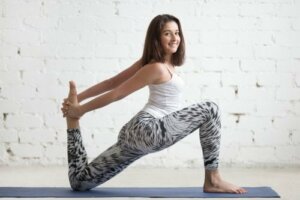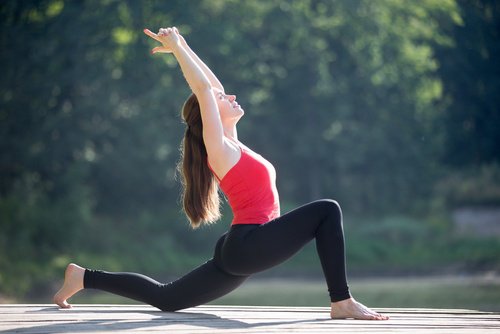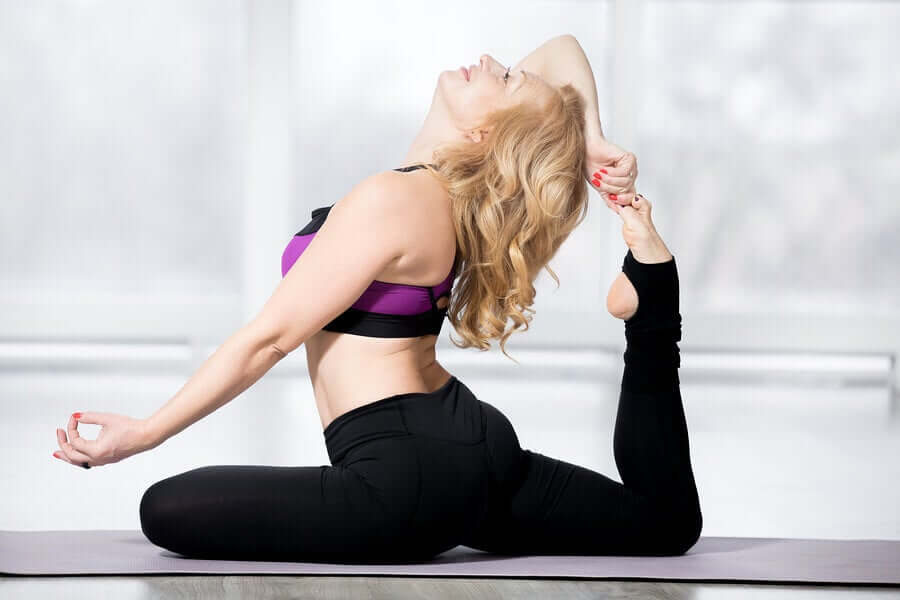3 Hip Flexor Stretches to Add to Your Exercise Routine


Written and verified by the physiotherapist Michelle Torres
Hip flexor stretches can, among other things, decrease hip and lower back pain. However, when is it advisable to do them? And when is it best to avoid them?
First, to answer these questions, you need to have a clear idea of what which muscles we’re talking about.
The hip flexors are the muscles that bring the knee toward the chest. The most important of these are the quadriceps and the psoas iliac. They’re constantly at work; when you walk, go up or down stairs, if you change positions in your chair, and so on. In turn, they help stabilize the lower spine and hip.
When to perform hip flexor stretching
- In case you have a feeling of tension or compression in the front part of the hip.
- If you have pain in your lower back or hip, especially when you spend a lot of time in one position (standing or in a chair, for example).
- If you haven’t previously done hip flexor stretches to decrease your symptoms.
When to avoid hip flexors

Unless your health care professional indicates otherwise, these are common circumstances in which you should avoid doing hip flexor stretches:
Before exercising
Stretching before doing any physical activity decreases the strength the muscle can exert. This phenomenon is called “stretch-induced strength loss”. It’s not permanent, but it can diminish your athletic performance and predispose you to injury. The exception to this rule applies to gymnasts and dancers.
If that’s all you do to prevent injury
Stretching as a unique method of treatment hasn’t proven to be effective in reducing the incidence of musculoskeletal injuries. However, if you combine it with an individualized exercise program, it may be beneficial in certain cases.
You may be interested in: Symptoms of Hip Wear and How to Prevent It
If you’ve previously performed them to reduce symptoms
If you have already done hip flexor stretching to decrease any symptoms and:
- There’s been no major difference in symptoms.
- The intensity of the symptoms has increased.
- Symptoms decrease for a while but then return.
In any of these cases, you’re better off going to your trusted physical therapist for an evaluation and individualized treatment.
How do I perform hip flexor stretches?
You can do the following stretches in different ways:
Static stretch
This is the traditional stretch, where you hold the position for a certain time. In general, when you are going to do a static stretch:
- The sensation you should look for is that of a slight stretch. It shouldn’t hurt.
- You should hold the stretch for between 15 and 30 seconds, doing 3-4 repetitions.
- For older adults (65 or older), you should hold the stretch for 30 to 60 seconds for best results.
- You can do it 2-3 times a week.
- If you do it after a short warm-up, you’ll get better results in the short term.

PNF
This stands for “Proprioceptive Neuromuscular Facilitation“. Here you combine the contraction and the stretching of the muscle you want to work.
It’s one of the best techniques to improve active range of motion (ROM), especially in the short term. The easiest way to do PNF is with the help of someone else or external resistance. To do it:
- Stretch the muscle you want to work.
- Your assistant will apply slight pressure in the direction of the stretch, while you hold it for 10 seconds.
- At the end of this time, count up to 5 seconds and repeat the process 2 or 3 more times.
Don’t miss out: Muscle Stretching or Muscle Strengthening: Which Is Best?
Which stretch is better?
Both types offer the same results, although some people find one stretch better than the other.
So, try the same stretch with the static technique one day and try it with FNP the next. Continue with the one that makes you feel better afterward. Remember that it’s your body and no one knows it better than you.
3 hip flexor stretches

1. Quadriceps stretch
- First, lie on your stomach.
- Then, use one hand to lift the heel of the leg that you want to work to the buttock. Hold the position if you choose the static stretch method.
- If you’re doing PNF, you can offer resistance yourself. Just try to extend your leg while holding the hand that’s holding the heel.
- Finally, if you can get the heel to the buttock without a problem, move on to the next stretch.
2. Psoas stretch
Let’s say, for example, that you want to stretch the right psoas:
- To begin, get into a lunge position, with your left leg in front of you and your right leg resting on the floor.
- Your foot of your left leg will rest firmly on the floor and you’ll bend your knee at 90°.
- You can rest your right leg on a pillow, cushion, or rolled-up towel if contact with the ground bothers you.
- Keep your eyes forward, with your trunk perpendicular to the ground.
- Then, contract your right buttock and, gently, push your right hip forward. Don’t shift the position of your trunk.
- Hold the position if you’re doing a static stretch.
- If it’s a PNF stretch, then press your knee to the ground for 10 seconds.
- If you lean your trunk slightly backward, you can increase the intensity of the stretch.
3. Quadriceps + psoas stretch
In this case, you follow the same steps to stretch the psoas, except you take the ankle of the leg you0re stretching and bring it closer to the buttocks. This stretch is very intense so be sure to master the previous ones before trying it.
Final recommendations
There’s no such thing as the “perfect” stretch. Rather, there’s the ideal stretch for you and for what you need at any given time. Two people may have the same symptoms and need completely different treatments.
Similarly, something that used to work for you may no longer work now. And that’s normal – your body changes and adapts. That’s why you must pay attention to how you feel before, during, and after you stretch your hip flexors.
Finally, remember that when it comes to the body, the effects are cumulative. The secret is to do it often, at least once a day. Be patient. Your body will thank you!
All cited sources were thoroughly reviewed by our team to ensure their quality, reliability, currency, and validity. The bibliography of this article was considered reliable and of academic or scientific accuracy.
- Phil Page. 2012. Current concepts in muscle stretching for exercise and rehabilitation. International Journal of Sports Physical Therapy 2017; 7(1): . https://www.ncbi.nlm.nih.gov/pmc/articles/PMC3273886/
- Matthew Mills, Barnett Frank, Shiho Goto, Troy Blackburn, Samantha Cates, Michael Clark, et al.. Effect of restricted hip flexor muscle length on hip extensor muscle activity and lower extremity biomechanics in college-aged female soccer players. International Journal of Sports Physical Therapy. 2015; 10(7): . https://www.ncbi.nlm.nih.gov/pmc/articles/PMC4675195/
- Lempke L, Wilkinson R, Murray C, Stanek J.. The Effectiveness of PNF Versus Static Stretching on Increasing Hip-Flexion Range of Motion. Journal of Sports Rehabilitation 2018; 27(3): https://www.ncbi.nlm.nih.gov/pubmed/28182516
- Hussain I Younis Aslan, Harsh H Buddhadev, David N Suprak, Jun G San Juan. Acute effects of two hip flexor stretching techniques on knee joint position sense and balance. International Journal of Sports Physical Therapy 2018; 13(5): . https://www.ncbi.nlm.nih.gov/pmc/articles/PMC6159495
This text is provided for informational purposes only and does not replace consultation with a professional. If in doubt, consult your specialist.








